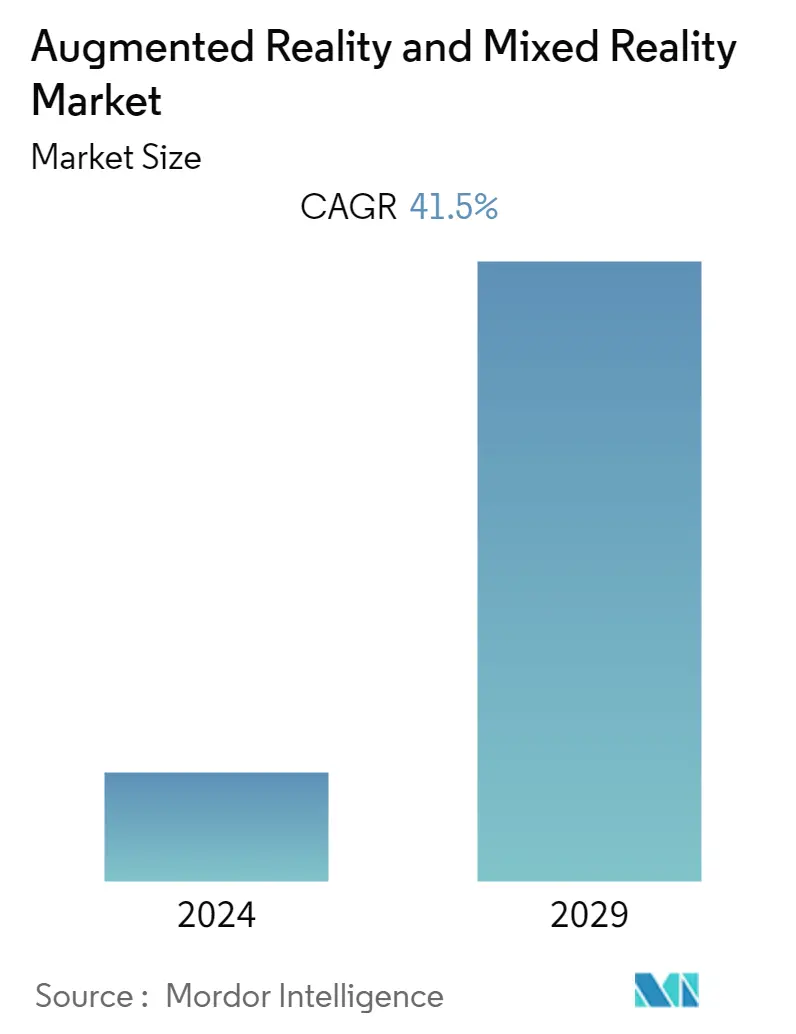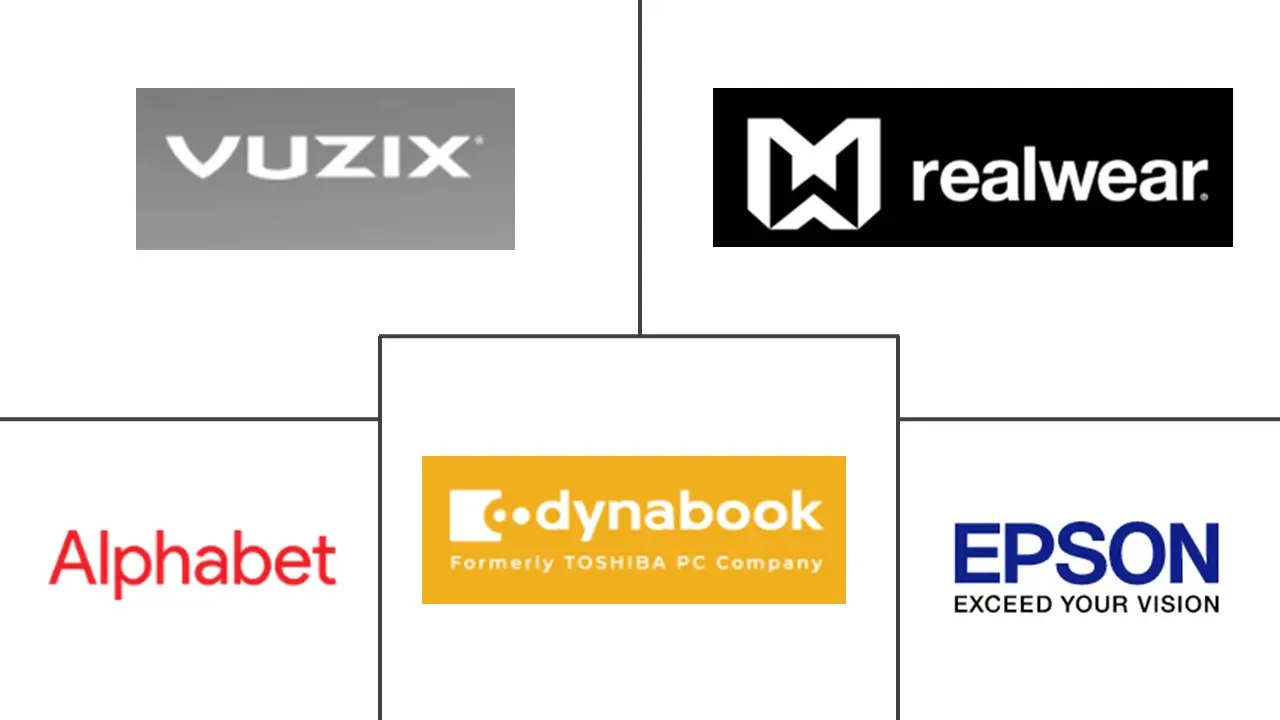Market Size of Augmented Reality & Mixed Reality Industry

| Study Period | 2019 - 2029 |
| Base Year For Estimation | 2023 |
| CAGR | 41.50 % |
| Fastest Growing Market | Asia Pacific |
| Largest Market | North America |
| Market Concentration | Low |
Major Players
*Disclaimer: Major Players sorted in no particular order |
Augmented Reality & Mixed Reality Market Analysis
Augmented reality is expected to register a CAGR of 41.50 %, and a mixed reality market is expected to register a CAGR of 43.28% over the forecast period. The world is thoroughly engrossed with two technologies, Virtual Reality (VR) and Augmented Reality (AR). An incredible merger of these two has become an extended reality known as mixed reality. It is a seamless intersection between Augmented Reality and Virtual Reality and combines both virtual worlds.
- Augmented Reality (AR) witnessed unprecedented growth in the current year with the explosion in the commercial use of the technology. It is expected to be one of the more prominent focal points in coming years as significant technology market leaders, such as Apple, Google, Facebook, Microsoft, and Amazon, are investing in innovation and adoption. The proliferation of smartphones and widespread adoption of AR in mobile gaming are driving the market, and major vendors in the market are increasingly developing solutions for the segment.
- Mobile marketers are using AR for various purposes and achieving several vital goals. Mobiles are helping customers find their way into a store by providing streamlined information, encouraging a sale by creating interactive experiences, and collecting meaningful data on demographics and behavior by analyzing who interacted through the app.
- AR has witnessed increasing implementation in existing applications and platforms, including gamification for customer engagement, AR applications, social media-based marketing, and enterprise collaboration for unified workplace communications (such as Microsoft HoloLens, for assessing insurance risks). In addition, game developers are anticipated to use AR as a differentiator that could encourage new downloads.
- One of the significant challenges AR technology faces is educating the wider audience - the broader market. The current applications being developed (to be used on smartphones, tablets, and wearables) are limited to single users. For AR to be more accessible, creating multi-user, uniform, and streamlined experiences is a must. In the current market scenario, the availability of such products is limited. This is acting as a significant challenge to market growth.
- Covid-19 has positively impacted AR/VR hardware demand, and enterprises across the globe are trying to find ways to get their internal and wider geographically spread teams to communicate, collaborate, and find a path forward during the crisis. Even after the lockdown ends, the behavioral change it has caused is likely to last for a considerably more extended period. People are expected to remain socially distant, but they would be virtually close with the usage of technologies and the comprehensive reality. These platforms and technologies may primarily allow multiple businesses to run and grow, irrespective of the challenges posed by social distancing.
Augmented Reality & Mixed Reality Industry Segmentation
Augmented reality does not take the user to the virtual world. It only enhances objects in the current world by superimposing virtual images. AR, thus, places virtual objects into an environment that exists in the real world.
Mixed reality combines the aspects of the virtual world with those of the real world. It enables users to interact with the two worlds. Unlike AR, virtual objects in MR are not just overlaid. Users can interact with them. It is the main feature that distinguishes MR from AR.
The Augmented Reality Market is Segmented by Type (Hardware, Software), End-user Verticals (Gaming, Education, Healthcare, Retail & Advertising, Automotive, Military & Defense), and Geography (North America, Europe, Asia-Pacific, Latin America, and Middle East & Africa).
The Mixed Reality Market is Segmented by End-user Verticals(Consumer, Medical & Healthcare, Industrial) and Geography (North America, Europe, Asia-Pacific, Latin America, and Middle East & Africa).
The market sizes and forecasts are provided in terms of value in USD million for all the above segments.
| By Type | |
| Hardware | |
| Software |
| By End-user Vertical | |
| Gaming | |
| Education | |
| Healthcare | |
| Retail and Advertising | |
| Automotive | |
| Military and Defense | |
| Other End-user Verticals |
| Geography | |
| North America | |
| Europe | |
| Asia-Pacific | |
| Rest of the World (Latin America and Middle East & Africa) |
Augmented Reality & Mixed Reality Market Size Summary
The Augmented Reality (AR) and Mixed Reality (MR) market is experiencing rapid expansion, driven by significant investments from major technology companies like Apple, Google, Facebook, Microsoft, and Amazon. These investments are fostering innovation and adoption, particularly in mobile gaming and smartphone applications. AR is increasingly being integrated into various sectors, including retail, healthcare, and enterprise collaboration, enhancing customer engagement and business processes. Despite its growth, the market faces challenges such as the need for multi-user experiences and broader audience education. The COVID-19 pandemic has further accelerated the adoption of AR and VR technologies, as businesses seek to maintain communication and collaboration in socially distanced environments.
The market landscape is highly fragmented, with both global players and SMEs competing for market share. Key players such as Google LLC, Seiko Epson Corporation, and Vuzix Corporation are actively engaging in partnerships, mergers, and innovations to strengthen their offerings. The Asia-Pacific region is witnessing significant growth due to increased smartphone penetration and government investments in AR startups. In healthcare, AR is being used for training and telemedicine, while in retail, companies like Sephora and Rolex are leveraging AR for virtual try-ons. The future of the AR market is poised for further growth as it continues to merge the virtual and physical worlds, creating interactive and personalized experiences for users.
Augmented Reality & Mixed Reality Market Size - Table of Contents
-
1. MARKET INSIGHTS
-
1.1 Market Overview
-
1.2 Industry Attractiveness - Porter's Five Force Analysis
-
1.2.1 Threat of New Entrants
-
1.2.2 Bargaining Power of Buyers
-
1.2.3 Bargaining Power of Suppliers
-
1.2.4 Threat of Substitutes
-
1.2.5 Intensity of Competitive Rivalry
-
-
1.3 Industry Value Chain Analysis
-
1.4 Assessment of the Impact of COVID-19 on the Market
-
-
2. AUGMENTED REALITY(AR) MARKET LANDSCAPE-MARKET SEGMENTATION
-
2.1 By Type
-
2.1.1 Hardware
-
2.1.2 Software
-
-
2.2 By End-user Vertical
-
2.2.1 Gaming
-
2.2.2 Education
-
2.2.3 Healthcare
-
2.2.4 Retail and Advertising
-
2.2.5 Automotive
-
2.2.6 Military and Defense
-
2.2.7 Other End-user Verticals
-
-
2.3 Geography
-
2.3.1 North America
-
2.3.2 Europe
-
2.3.3 Asia-Pacific
-
2.3.4 Rest of the World (Latin America and Middle East & Africa)
-
-
Augmented Reality & Mixed Reality Market Size FAQs
What is the current Augmented Reality & Mixed Reality Market size?
The Augmented Reality & Mixed Reality Market is projected to register a CAGR of 41.5% during the forecast period (2024-2029)
Who are the key players in Augmented Reality & Mixed Reality Market?
Google LLC (Alphabet Inc.), Seiko Epson Corporation, Vuzix Corporation, Realwear Inc. and Dynabook Americas Inc. (Sharp corporation) are the major companies operating in the Augmented Reality & Mixed Reality Market.

